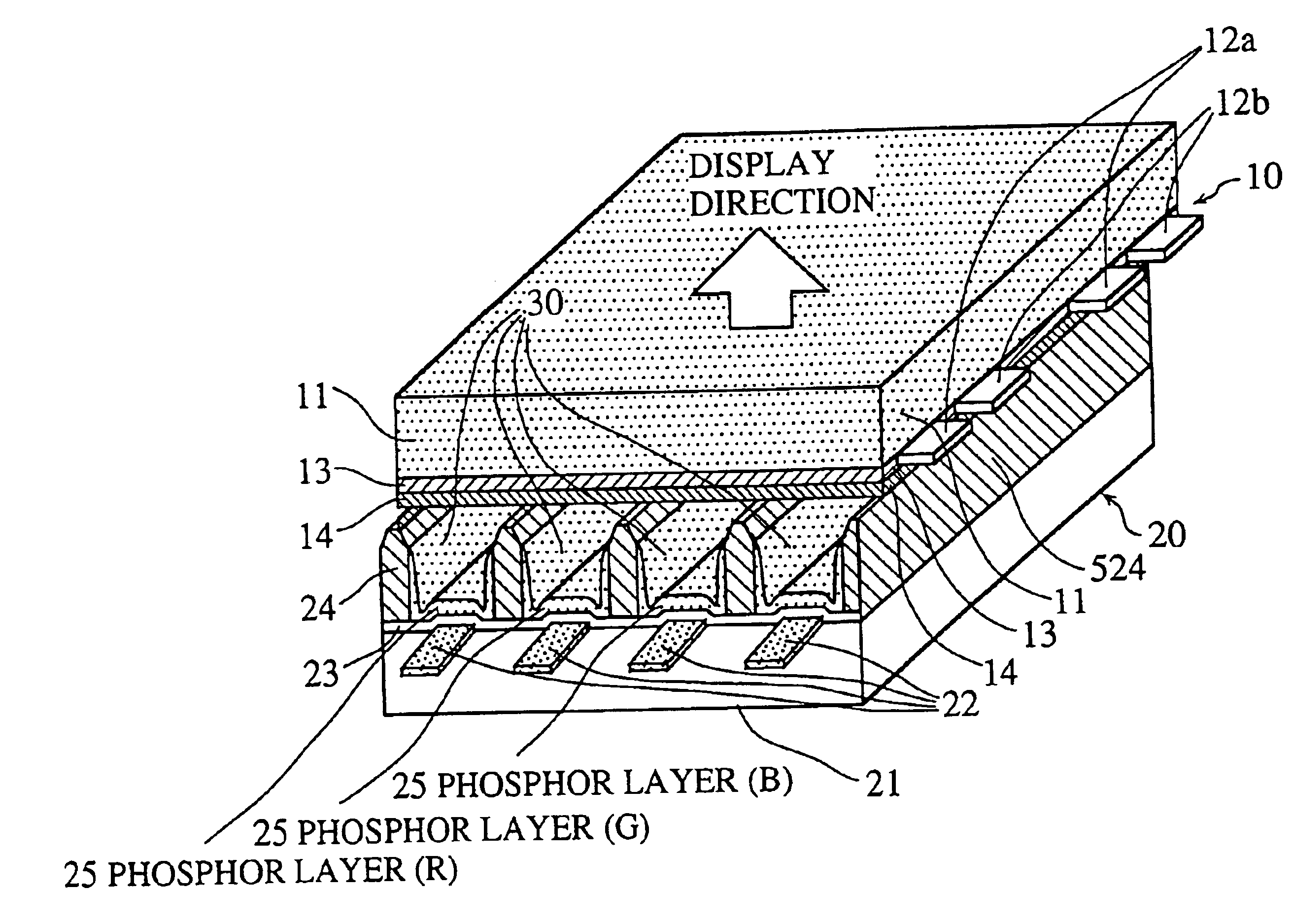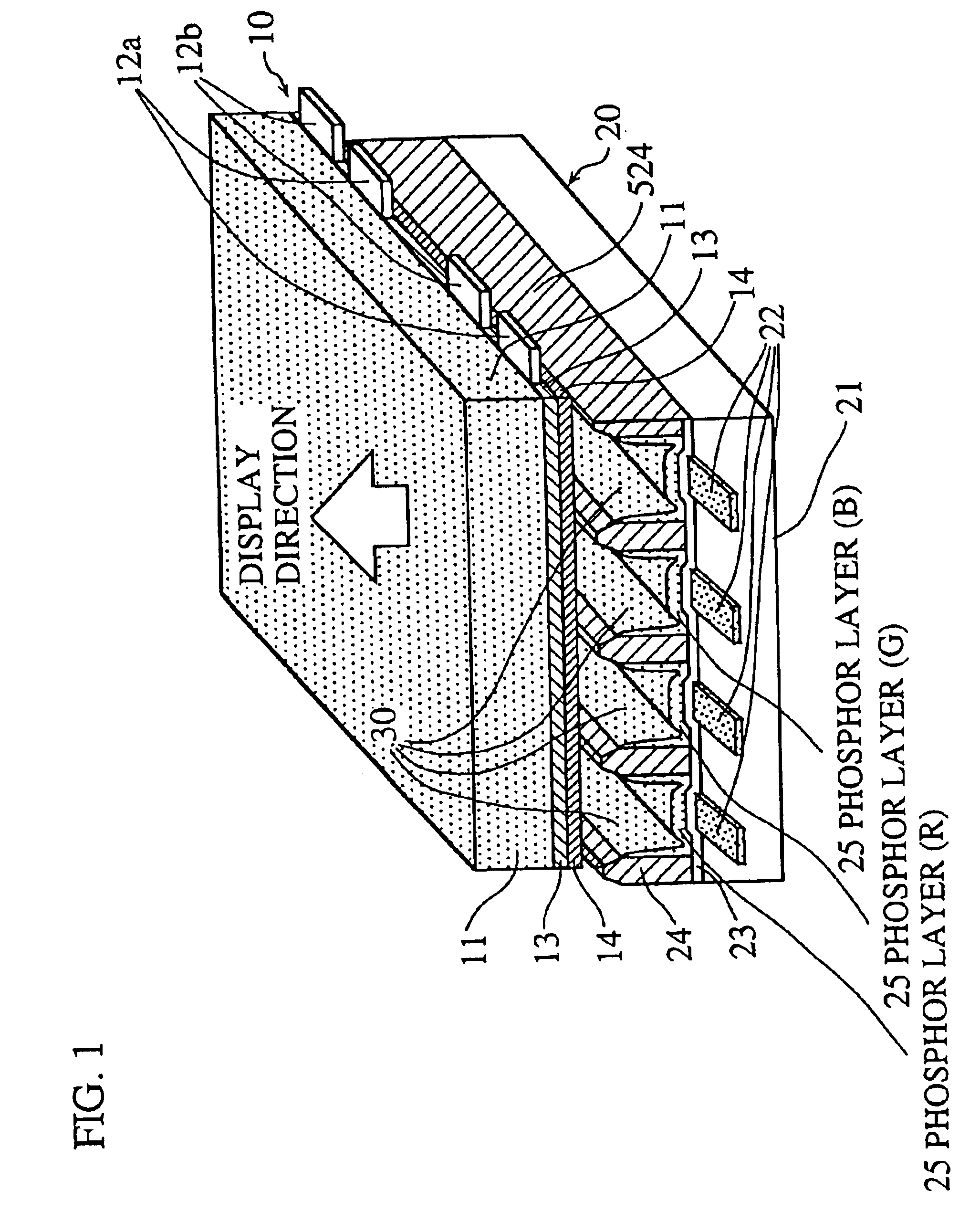Highly productive method of producing plasma display panel
a plasma display and high-productivity technology, which is applied in the manufacture of electrode systems, electric discharge tubes/lamps, discharge tubes luminescnet screens, etc., can solve the problems of reducing production costs and considerably higher production costs of pdps than crts, and achieve excellent light-emitting intensity and chromaticity, suppress phosphor deterioration, and suppress phosphor deterioration
- Summary
- Abstract
- Description
- Claims
- Application Information
AI Technical Summary
Benefits of technology
Problems solved by technology
Method used
Image
Examples
embodiment 1
Variations of Embodiment 1
(1) In the above embodiment, dry air is circulated in the internal space. However, a dry gas containing oxygen (an inert gas such as nitrogen) may be supplied to obtain the same effect.(2) In the production method described in the above embodiment, a constant amount of dry air is supplied to the internal space. However, the flow rate of the supplied air may be changed as necessary. Also, evacuation of the internal space and supply of dry air may be alternated. This enables oxygen to be supplied to the internal space and enables water vapor or the like that are generated in the internal space to be exhausted from there. This method also provides the above effect to some extent.(3) In the production method described in the above embodiment, a typical glass frit is used as the sealing material. However, a crystalline glass may be used instead. A typical crystalline glass is a PbO—ZnO—B2O3 base frit glass.
In the case where a normal frit glass is used as the sea...
examples
TABLE 1FRITSOFTENINGCRYSTALLIZATIONREQUIREDEXAMPLETEMPERATURE(°C.)POINTTEMP.TIMENo.PROFILET1T2T3T4TYPE(°C.)(°C.)(h)1FIG. 8——520350NORMAL450—62FIG. 8——520350NORMAL400—63FIG. 8——520350NORMAL380—64FIG. 8——520450NORMAL450—65FIG. 8——520200NORMAL450—6.56FIG. 9——520350NORMAL450—7.57 FIG. 10—450520350CRYSTALLINE3804506.5GLASS8 FIG. 11380—520350NORMAL450—9.59 FIG. 12520350520350NORMAL380—15
examples no.1-8
Examples No. 1-8 shown in Table 1 are PDPs manufactured by the method shown in Embodiment 1. In manufacturing these example PDPs, the frit preliminary baking process, phosphor baking process, and panel bonding / exhausting process are performed based on the temperature profiles shown in FIGS. 9-12, as shown in Table 1.
The example No. 9 is a PDP manufactured by a comparative method. In manufacturing this example PDP, the frit preliminary baking process, phosphor baking process, bonding process, and panel bonding / exhausting process are performed based on the temperature profile shown in FIG. 13.
The signs T1-T4 appearing in Table 1 and FIGS. 9-13 represent the following temperatures.T1: frit preliminary baking temperatureT2: frit crystalline temperatureT3: phosphor baking and panel bonding temperature (peak temperature)T4: exhausting temperature
It should be noted here that when each of Example PDPs No. 1-9 is manufactured, partitions 15a are formed when the sealing glass layer 15 is form...
PUM
 Login to View More
Login to View More Abstract
Description
Claims
Application Information
 Login to View More
Login to View More - R&D
- Intellectual Property
- Life Sciences
- Materials
- Tech Scout
- Unparalleled Data Quality
- Higher Quality Content
- 60% Fewer Hallucinations
Browse by: Latest US Patents, China's latest patents, Technical Efficacy Thesaurus, Application Domain, Technology Topic, Popular Technical Reports.
© 2025 PatSnap. All rights reserved.Legal|Privacy policy|Modern Slavery Act Transparency Statement|Sitemap|About US| Contact US: help@patsnap.com



